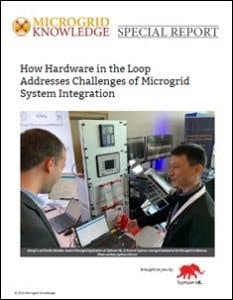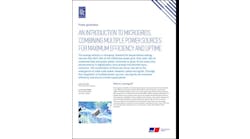In the third article of this special report series brought to you by Microgrid Knowledge and Typhoon HIL, we look at various ways of testing microgrid designs and explain the value of hardware in the loop (HIL).
Get the full report.
Microgrid design and validation tests can be carried out with real power equipment in a lab environment, such as the National Renewable Energy Laboratory’s (NREL) megawatt scale Energy Systems Integration Facility (ESIF). This federal laboratory allows manufacturers and integrators to test technology at actual power before implementation. But equipment can be damaged, in some cases multiple times before passing the test, making it a time consuming and costly process. In addition, power labs are inflexible and cannot be easily configured to resemble real-life microgrid operational scenarios, hence limiting their usefulness.
Digital simulations for testing microgrid designs
Offline digital simulations can be built ahead of lab testing to provide some assurance over results, but these lack fidelity. By definition, they are simulations where control and communication are often modeled using significant simplifications and abstractions. This is where hardware in the loop, or HIL testing, plays a role. Using HIL, physical controllers running actual software and firmware can be connected to a digital, real-time simulation of a microgrid power stage, the power processing part. Testing equipment and software in a simulated environment increases the fidelity, as these tests more closely resemble reality.
HIL testing is a well-established technique for the design and testing of complex systems, such as those found in the aviation and car industries. A new car contains many digital control units that must seamlessly interact with each other. Cameras, radars, driver assistance systems must all be tested together before the final product is complete. When a driver puts a foot down on the accelerator, the engine’s electronic control unit converts sensor measurements to increase the vehicle’s air intake. In a HIL test, the engine is replaced with a simulation. The control unit is tricked into thinking the engine is present, passing on signals.
Each electronic control unit of the car can interact with thousands of simulated use cases in the HIL testing environment. This pushes the control units to their limits and allows the system integrator to resolve software defects before they reach the final assembled product. This is achieved without the time and cost associated with physical testing.
Depending on the type of device under test, HIL testing can be classified into different categories:
- P-HIL: If the device under test is power apparatus, connected to a simulation of the rest of the system, it is referred to as a power-HIL or P-HIL simulation. This type of testing gives high fidelity, at lower costs than a full power test.
- C-HIL: If the device under test is a controller, it is referred to as a controller HIL or C-HIL simulation. Again this can provide high fidelity, at lower costs than a full power test or P-HIL.
Other hardware in the loop applications
More recently, HIL testing has been applied to power systems. The IEEE’s P2004: Hardware in the Loop Simulation Based Testing of Electric Power Apparatus and Controls, approved in 2017, establishes simulation development practices and HIL-specific documentation, verification and validation. It also serves as a platform to promote HIL testing and educate the industry about this method.
See the full report to learn more about how hardware in the loop (HIL), specifically controller hardware in the loop (C-HIL), is an ideal technique for testing the functionality of microgrid controllers.
And check out the previous articles in the series below:
- Hardware in the Loop: Addressing the Challenges of Microgrid Systems Integration.
- Design and Validation of Microgrids.
Download the full report “How Hardware in the Loop Addresses Challenges of Microgrid System Integration” courtesy of Typhoon HIL to learn more.







